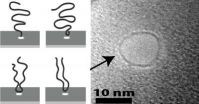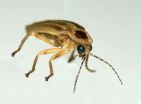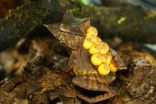(Press-News.org) Clinical pharmacologist Jens Titze, M.D., knew he had a one-of-a-kind scientific opportunity: the Russians were going to simulate a flight to Mars, and he was invited to study the participating cosmonauts.
Titze, now an associate professor of Medicine at Vanderbilt University, wanted to explore long-term sodium balance in humans. He didn't believe the textbook view – that the salt we eat is rapidly excreted in urine to maintain relatively constant body sodium levels. The "Mars500" simulation gave him the chance to keep salt intake constant and monitor urine sodium levels in humans over a long period of time.
Now, in the Jan. 8 issue of Cell Metabolism, Titze and his colleagues report that – in contrast to the prevailing dogma – sodium levels fluctuate rhythmically with 7-day and monthly cycles. The findings, which demonstrate that sodium is stored in the body, have implications for blood pressure control, hypertension and salt-associated cardiovascular risk.
Titze's interest in sodium balance was sparked by human space flight simulation studies he conducted in the 1990s that showed rhythmic variations in sodium urine excretion.
"It was so clear to me that sodium must be stored in the body, but no one wanted to hear about that because it was so different from the textbook view," he said.
He and his team persisted with animal studies and demonstrated that the skin stores sodium and that the immune system regulates sodium release from the skin.
In 2005, planning began for Mars500 – a collaboration between Russia, the European Union and China to prepare for manned spaceflight to Mars. Mars500 was conducted at a research facility in Moscow between 2007 and 2011 in three phases: a 15-day phase to test the equipment, a 105-day phase, and a 520-day phase to simulate a full-length manned mission. Crews of healthy male cosmonauts volunteered to live and work in an enclosed habitat of sealed interconnecting modules, as if they were on an international space station.
Titze and his colleagues organized the food for the mission and secured commitments from the participants to consume all of the food and to collect all urine each day. They studied twelve men: six for the full 105-day phase of the program, and six for the first 205 days of the 520-day phase.
"It was the participants' stamina to precisely adhere to the daily menu plans and to accurately collect their urine for months that allowed scientific discovery," Titze said.
The researchers found that nearly all (95 percent) of the ingested salt was excreted in the urine, but not on a daily basis. Instead, at constant salt intake, sodium excretion fluctuated with a weekly rhythm, resulting in sodium storage. The levels of the hormones aldosterone (a regulator of sodium excretion) and cortisol (no known major role in sodium balance) also fluctuated weekly.
Changes in total body sodium levels fluctuated on monthly and longer cycles, Titze said. Sodium storage on this longer cycle was independent of salt intake and did not include weight gain, supporting the idea that sodium is stored without accompanying increases in water.
The findings suggest that current medical practice and studies that rely on 24-hour urine samples to determine salt intake are not accurate, he said.
"We understand now that there are 7-day and monthly sodium clocks that are ticking, so a one-day snapshot shouldn't be used to determine salt intake."
Using newly developed magnetic resonance imaging (MRI) technologies to view sodium, Titze and his colleagues have found that humans store sodium in skin (as they found in their animal studies) and in muscle.
The investigators suspect that genes related to the circadian "clock" genes, which regulate daily rhythms, may be involved in sodium storage and release.
"We find these long rhythms of sodium storage in the body particularly intriguing," Titze said. "The observations open up entirely new avenues for research."
INFORMATION:
The studies were supported by grants from the German Federal Ministry for Economics and Technology/DLR Forschung unter Weltraumbedingungen and the Interdisciplinary Center for Clinical Research at Friedrich-Alexander-University, Erlangen-Nürnberg, Germany. Food products were donated by a number of organizations.
END
Researchers have found new evidence that metabolic stress can increase the onset of atrial arrhythmias, such as atrial fibrillation (AF), a common heart condition that causes an irregular and often abnormally fast heart rate. The findings may pave the way for the development of new therapies for the condition which can be expected to affect almost one in four of the UK population at some point in their lifetime.
The British Heart Foundation (BHF) study, led by University of Bristol scientists and published in Circulation: Arrhythmia and Electrophysiology, found that metabolic ...
PROVIDENCE, R.I. [Brown University] — If you want to understand a novel, it helps to start from the beginning rather than trying to pick up the plot from somewhere in the middle. The same goes for analyzing a strand of DNA. The best way to make sense of it is to look at it head to tail.
Luckily, according to a new study by physicists at Brown University, DNA molecules have a convenient tendency to cooperate.
The research, published in the journal Physical Review Letters, looks at the dynamics of how DNA molecules are captured by solid-state nanopores, tiny holes that ...
The nighttime twinkling of fireflies has inspired scientists to modify a light-emitting diode (LED) so it is more than one and a half times as efficient as the original. Researchers from Belgium, France, and Canada studied the internal structure of firefly lanterns, the organs on the bioluminescent insects' abdomens that flash to attract mates. The scientists identified an unexpected pattern of jagged scales that enhanced the lanterns' glow, and applied that knowledge to LED design to create an LED overlayer that mimicked the natural structure. The overlayer, which increased ...
For over 100 years, it was assumed that the penicillin-producing mould fungus Penicillium chrysogenum only reproduced asexually through spores. An international research team led by Prof. Dr. Ulrich Kück and Julia Böhm from the Chair of General and Molecular Botany at the Ruhr-Universität has now shown for the first time that the fungus also has a sexual cycle, i.e. two "genders". Through sexual reproduction of P. chrysogenum, the researchers generated fungal strains with new biotechnologically relevant properties - such as high penicillin production without the contaminating ...
Athens, Ga. – On the list of undesirable medical conditions, a parasitic worm infection surely ranks fairly high. Although modern pharmaceuticals have made them less of a threat in some areas, these organisms are still a major cause of disease and disability throughout much of the developing world.
But parasites are not all bad, according to new research by a team of scientists now at the University of Georgia, the Harvard School of Public Health, the Université François Rabelais in Tours, France, and the Central South University, Changsha, Hunan, China.
A study ...
The research carried out at IIASA in collaboration with the Potsdam Institute for Climate Impact Research demonstrates that there is fundamental rigidity, known as lock-in, within the energy economy that favors the use of fossil fuels and nuclear power despite their large environmental and social costs. The researchers identify that this rigidity of the existing energy economy could be considerably reduced by introducing new rules that hold shareholders of companies liable for the damages caused by the companies they own. Allocating the liability between the company and ...
The flick of an antenna may be how a male wasp lays claim to his harem, according to new research at Simon Fraser University.
A team of biologists, led by former PhD graduate student Kelly Ablard, found that when a male targeted a female, he would approach from her from the left side, and once in range, uses the tip of his antenna to tap her antenna.
Ablard suggests the act transfers a yet unidentified specimen-specific pheromone onto the female's antenna that marks the female as "out of bounds," or "tagged."
The tagging-pheromone helps a male relocate the females ...
Graphene oxide has a remarkable ability to quickly remove radioactive material from contaminated water, researchers at Rice University and Lomonosov Moscow State University have found.
A collaborative effort by the Rice lab of chemist James Tour and the Moscow lab of chemist Stepan Kalmykov determined that microscopic, atom-thick flakes of graphene oxide bind quickly to natural and human-made radionuclides and condense them into solids. The flakes are soluble in liquids and easily produced in bulk.
The experimental results were reported in the Royal Society of Chemistry ...
What if Noah got it wrong? What if he paired a male and a female animal thinking they were the same species, and then discovered they were not the same and could not produce offspring? As researchers from the Smithsonian's Panama Amphibian Rescue and Conservation Project race to save frogs from a devastating disease by breeding them in captivity, a genetic test averts mating mix-ups.
At the El Valle Amphibian Conservation Center, project scientists breed 11 different species of highland frogs threatened by the chytrid fungus Batrachochytrium dendrobatidis, which has already ...
The American Chemical Society (ACS), the world's largest scientific society, today launched a new video series that will feature noted scientists discussing the status of knowledge in their fields, their own research, and its impacts and potential impacts on society. Chemistry over Coffee: Conversations with Celebrated Scientists is available at www.acs.org/ChemistryOverCoffee.
The launch episode features Chad Mirkin, Ph.D., and Paul Weiss, Ph.D., internationally known leaders in nanotechnology. Mirkin, director of Northwestern University's International Institute for ...


